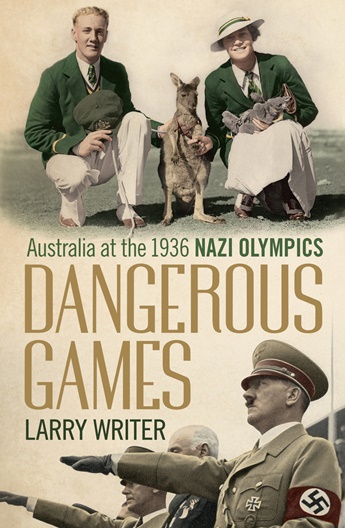Larry Writer has provided a most readable dissection of possibly the most disreputable Olympic Games in the history of the Olympic movement.
The author is an accomplished sports writer and as such has narrated an intriguing storyline of the pre-conditions that allowed Germany to be awarded the 1936 Olympic Games. Having previously been awarded the abandoned Berlin 1916 Olympic Games through WW I, they were forbidden to participate in the Antwerp 1920 and Paris 1924 Olympic Games. However by 1931 world opinion had changed and as the popular President, Paul Von Hindenberg, of the ‘Weimar Republic had given his imprimatur to the German Olympic Committee they won a popular victory over Barcelona. Writer then tracks the political changes within Germany leading to Hitler’s Third Reich and the manipulation of world opinion for the Games to even be held in spite of Germany’s brazen preparation for war to achieve Hitler’s ‘lebensraum’ or ‘living space’ and his manic policy in relationship to the purity of the German Aryan race.
Against this backdrop the author describes the Australian federated sports landscape of that period with its parochialism and strong personalities, especially between Victoria and New South Wales. He covers the flawed selection process, lack of appropriate training facilities, lack of funds and support from all governments and even the lack of knowledge re contemporary international facilities and training standards. This latter factor is highlighted by Australian swimming and athletic events still in yards while the world was in metres, athletes running on grass as opposed to cinders tracks and swimmers mainly in unheated salt water pools as opposed to heated indoor fresh water pools. The wrestlers didn’t even know the international competition rules!
Writer then intertwines the stories of all 33 Athletes and five officials of the Australian Olympic Team that finally made it to Berlin, through their convoluted selection process, their 37 day voyage to Europe without proper training equipment or facilities and their arrival five weeks before the Games Opening Ceremony. The team without exception were overawed by the realities of modern Berlin, the sports facilities especially training and the grandeur of the stadia and the city itself. Even worse the reality of their physical condition after the long voyage and the injuries sustained trying to gain fitness under totally different conditions from home. Another shock was their naivety as to what German and Japanese nationalistic sports regimes had achieved through intense and scientific training not to forget the competitive sports system of the USA.
His detailed description of each of the 12 days of the Berlin Games of the XIth Olympiad paints a picture of each Australian’s performance against the odds, the international highlights and the ‘Hitlerisation’ of these Games.
The aftermath of the 1936 Games is covered from an international and Australian point of view and Harold Alderson’s AOT Manager’s Report did not hold back on Australia’s ‘blissful ignorance’ of what was required to truly compete at the international level in terms of facilities, specialist coaches and training methods, however Alderson’s problem was that he was unashamedly an amateur proponent.
Just when you feel the story has come to the end Larry Writer introduces heart warming stories of what all members of that Australian Olympic Team did with the rest of their lives.
The book is a very readable narrative of a troubled period involving our sports history and provides a rational dissection of ‘worlds apart’ at that time of ‘democracy versus nationalism’ and ‘professionalism versus amateurism’. There are eight pages of historical photographs. The author freely acknowledges his sources of information, backed up with incisive interviews of surviving AOT members or their friends and families in his opening Prologue ‘The Wattle and the Swastika’.
This is great read for all tastes, the sports or history ‘buff’ and those that like real life stories.

Contact Jim Barry about this article.






